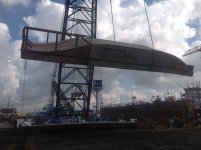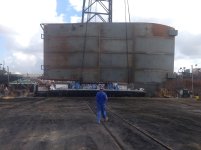dmort
Active member
Riggers
When you are working in the trades it is often said the other guys have it easier then you. Of course, sometimes it's true and sometimes it isn't.
To witness riggers moving heavy machinery from the engineering spaces on a ship topside or to the flight deck is an education in itself. They would often have eyes welded to the bulkheads to assist the process.
Sometimes they would have a passageway blocked which made it a little inconvenient for some people to get to their job site... That's usually when the B****'n would start.
One of my personal experiences with riggers was finding one....at night. The night shift could be pretty slow and a limited number of riggers were available. The trick was to find the coffee.
On a live ship the galley would be open late into the night. Although it wasn't legit you could usually get your thermos filled. It was also a good place to find a rigger waiting for a job.
Mort
When you are working in the trades it is often said the other guys have it easier then you. Of course, sometimes it's true and sometimes it isn't.
To witness riggers moving heavy machinery from the engineering spaces on a ship topside or to the flight deck is an education in itself. They would often have eyes welded to the bulkheads to assist the process.
Sometimes they would have a passageway blocked which made it a little inconvenient for some people to get to their job site... That's usually when the B****'n would start.
One of my personal experiences with riggers was finding one....at night. The night shift could be pretty slow and a limited number of riggers were available. The trick was to find the coffee.
On a live ship the galley would be open late into the night. Although it wasn't legit you could usually get your thermos filled. It was also a good place to find a rigger waiting for a job.
Mort
Last edited:




